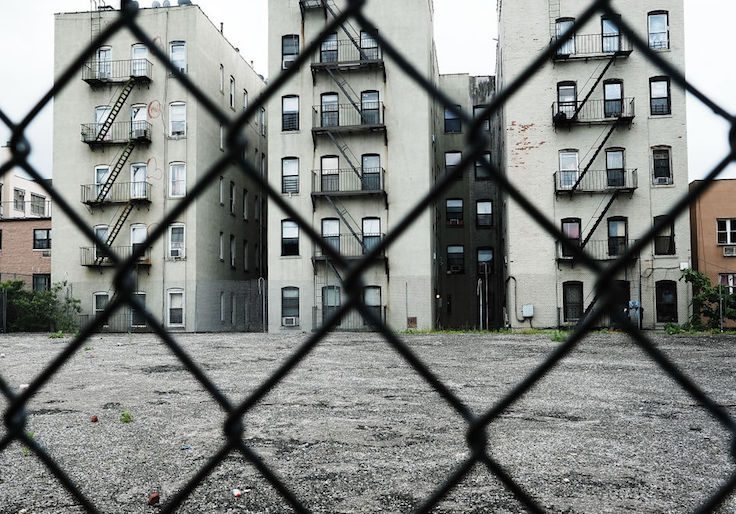If there is one quibble to be had with Dignity, photo journalist Chris Arnade's debut book, it's that it could use somewhat less of Chris Arnade.
At the book's heart is a division of America into two halves. One half, the "front row," is the world of the high-status: the third of Americans with college degrees, the half who have a positive net worth, the denizens of Manhattan and San Francisco and L.A. who are social-capital rich, even when financially poor. These are the people who feature in most of our television and many of our movies, and whose petty dramas make the front page of the Washington Post.
Arnade, who is from west-central Florida, was not born into this world. But after leaving home he joined it, first with a Ph.D. from Johns Hopkins and then a lucrative job on Wall Street. Of course, "like most successful and well-educated people, especially those in NYC," he believed that his status did not mean he was disconnected from reality: "I considered myself open-minded, considered, and reflective about my privilege."
But the financial crisis—and his banking colleagues' smooth sailing through it—left Arnade disillusioned and frustrated. That was why, in 2011, he started exploring what he calls "back row" America, first in the beaten-down Bronx neighborhood of Hunts Point, and then in his van all across the United States.
From the Milwaukee ghetto to Prestonburg, Kentucky, Arnade crisscrossed the country. He met the people without a college degree, the half of America whose children are likely to be fatherless, who all know someone who has died from drinking, drugs, or suicide. This was a multiyear project: Arnade's dispatches from "back row" America during the 2016 election were, as Matthew Walther puts it, "practically the only journalism of any value done at the time."
Dignity is a book about giving voice to the voiceless, and it should be assessed by how well it achieves this goal. Where it succeeds it is moving, even heart-wrenching. But even the ways in which it fails tell us something about the problems of connecting America’s two halves.
About a third of Dignity is Arnade relating how he came to understand the difference between the "back row" and the "front row." Each chapter contains at least a few pages of his marveling at the difference between the lives of the people he meets, and his life or the lives of his peers.
Arnade's goal, perhaps, is to elicit a similar understanding in a mostly "front row" readership. But there is something off-putting about a book ostensibly about the silenced class containing so many instances of the word "I." At worst, Dignity can feel like every college applicant's personal statement: "I knew I was privileged, but then I went to Hunts Point, and that's where I learned…"
If this seems unfair to Arnade—whose reportorial skills and empathy far exceed those of your average college admit—take it as evidence of a deeper pathology. After all, isn't compulsively relating one's own story and situating everything in relation to one's identity the new tic of "front row" America? It is a given in high-status culture that identity is prior to truth and ultimately validates what is and is not true. Arnade may be trying to simply acknowledge his own privilege, but his compulsion to follow this identity-truth ritual makes clear its problematic limits.
If this is Dignity at its weakest, then the book is at its strongest when Arnade lets others speak. Arnade's reportorial method was simple: He would arrive in a new town, find the nearest McDonald's (Arnade is a big proponent of McDonald's-as-community-center), and talk to people. The reader is treated to portraits of deep religious belief in Youngstown; of the horrors of modern racism in Selma; and of the deep love of home that keeps people even in downtrodden Cairo, Illinois.
And where words fail, there are the photographs. Dignity gives up at least half its space to full-color prints of the best of Arnade's more than 70,000 stills. Mostly portraits, their subjects—men and women, old and young, black and white—are drawn from across the "back row." They capture joys and sorrows: a baseball game, boys playing in the fire hydrant, prayer at a mosque, drug use, and of course countless shots of people at McDonald's.
Other reviewers have drawn comparisons to Danish photographer Jacob Riis's photographs of 1880s New York slum life in How the Other Half Lives. The connection is obvious—indeed, the book's opening flap even makes it—but stretches only as far as subject matter. Riis is described as a social reformer, whose photographs were meant to turn public sentiment. The necessary consequence of this is that the subject of many of his photographs is the social conditions in which people exist, not the people themselves.
Arnade's photos are different. They do not preach, but simply depict. Portraits as a form carry a certain nobility, and these portraits are no exception. Arnade's work shows the power of photography to render a person as a person, not just a product of his circumstances or a series of statistics. In other words, they acknowledge something in all of their subjects: dignity.
This representation is in every way the opposite of the form of Arnade's self-narration, which needlessly mediates the other's experience through the lens of his own experience. The book frankly would have been more effective if it contained only the photos and the words of their subjects, with its author faded into the background.
Arnade ends Dignity with an imperative: "We all need to listen to each other more." The book is a powerful depiction of how to do that listening—and, sometimes, how not to. Maybe Arnade's "front row" peers are as cloistered and disconnected as he makes them out to be. If so, Dignity is as good a place as any for them to start.
